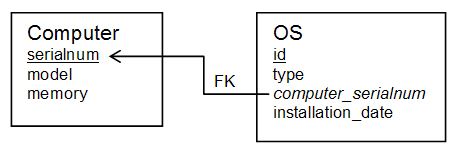Notice: this Wiki will be going read only early in 2024 and edits will no longer be possible. Please see: https://gitlab.eclipse.org/eclipsefdn/helpdesk/-/wikis/Wiki-shutdown-plan for the plan.
Difference between revisions of "COSMOS CMDBf Query to SQL Mapping"
(→Schema) |
|||
| Line 11: | Line 11: | ||
'''Schema 1''' | '''Schema 1''' | ||
| + | [[Image:Schema1.jpg]] | ||
'''Schema 2''' | '''Schema 2''' | ||
| + | |||
| + | [[Image:Schema2.jpg]] | ||
Both schemas are for modeling relationships between operating system (OS) instances with computers. An operating system instance can be installed on one computer. In the first schema, the relationship is represented by the foreign key from the OS table to the Computer table. In the second schema, the relationship is represented by a separate table. | Both schemas are for modeling relationships between operating system (OS) instances with computers. An operating system instance can be installed on one computer. In the first schema, the relationship is represented by the foreign key from the OS table to the Computer table. In the second schema, the relationship is represented by a separate table. | ||
Revision as of 17:14, 26 May 2008
Contents
Overview
MDRs and federating CMDBs support CMDBf query services, which accepts queries in CMDBf query format. The query service interprets the CMDBf query and queries the underlying data store for data. We can safely assume that no database or application would understand the CMDBf query today, as it is a new standard. So the MDR or ferderating CMDB would need to translate the CMDBf query to another query language, or invoke an appropriate method call of the application that serves the data for the MDR.
It is common to have data stored in relational databases. It is useful to come up with a set of guidelines for mapping CMDBf queries to SQL, and vice versa.
CMDBf query only supports a subset of SQL query capabilities, and there are CMDBf queries that are difficult to be done with SQL. The goal is to cover the basic queries that allows a two-way mapping between CMDBf query and SQL.
Schema
The examples below will use the following two schema definitions. These two schemas are equivalent but the CMDBf queries may be different.
Schema 1
Schema 2
Both schemas are for modeling relationships between operating system (OS) instances with computers. An operating system instance can be installed on one computer. In the first schema, the relationship is represented by the foreign key from the OS table to the Computer table. In the second schema, the relationship is represented by a separate table.
Mapping
Queries
Find all computers
SQL: select * from Computer
CMDBf Query:
<s:query xmlns:s="http://cmdbf.org/schema/1-0-0/datamodel">
<s:itemTemplate id="computers">
<s:recordConstraint >
<s:recordType namespace="http://www.eclipse.org/cosmos/examples" localName="Computer" >
</s:recordType>
</s:recordConstraint>
</s:itemTemplate>
</s:query>
Find computers with model equals "A123"
SQL: select * from Computer where model=A123
CMDBf Query:
<s:query xmlns:s="http://cmdbf.org/schema/1-0-0/datamodel">
<s:itemTemplate id="computers">
<s:recordConstraint >
<s:recordType namespace="http://www.eclipse.org/cosmos/examples" localName="Computer" >
</s:recordType>
<s:propertyValue namespace="http://www.eclipse.org/cosmos/examples" localName="model" >
<s:like negate="false" caseSensitive="false" >DS% </s:like >
</s:propertyValue>
</s:recordConstraint>
</s:itemTemplate>
</s:query>
3. Find computers with 2G memory or more select * from Computer where memory > 2000
4. Find computers with serial number XYZ select * from Computers where serialnum=XYZ
5. Find computers running Windows select * from Computer, OS where OS.computer_serialnum=Computer.serialnum and OS.type=WINDOWS
6. Same query as #5, but only include columns in Computer table in the result select Computer.serialnum, Computer.model, Computer.memory from Computer, OS where OS.computer_serialnum=Computer.serialnum and OS.type=WINDOWS
7. Same query as #5, but only include serial number in the result. select Computer.serialnum from Computer, OS where OS.computer_serialnum=Computer.serialnum and OS.type=WINDOWS
8. Find computers running Windows, installed in 2008 (schema 2 only) select * from Computer, OS where OS.computer_serialnum=Computer.serialnum and OS.type=WINDOWS and installedOn > 2008-01-01


